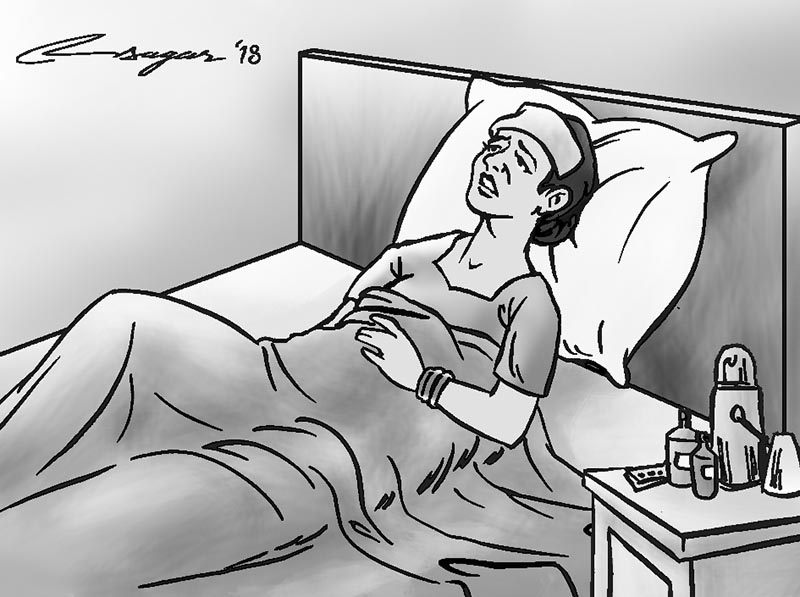Dengue-like illness: A public health threat
There have been reports in which patients were found to be showing symptoms akin to those of dengue, but during laboratory tests, they tested negative for dengue. Emergence of dengue-like illness hence is a major public health concern
A few days ago, a 28-year-old female was admitted to the hospital with a seven-day history of high-grade fever, red eyes, body ache, abdomen pain and rash, with a rapid drop in platelet count. She was from dengue-endemic area. However, serology for possible infectious diseases including dengue tested negative.
Last year, dozens of people from Lalbandi, Sarlahi were hospitalised for viral fever that imitated symptoms of dengue. But they tested negative for dengue. “Lalbandi Syndrome” then became popular among health care providers for this dengue-like illness.
Frequent appearance of “Lalbandi Syndrome” of unknown origin is a matter of grave concern from the public health viewpoint.
In India, there has been a marked increase in number of reported cases of dengue-like illness (in Kolkata and Pune in 2016 and in Bengaluru in 2017). One case of dengue-like illness was reported in 1935 in San Francisco, USA. Similarly, another US state Iowa also reported dengue-like illness in children in 1943. In recent cases in India also, children in particular were found to be vulnerable to this syndrome.
It must be noted that there have been accounts of researchers usually not performing laboratory tests for a second time to identify other possible causes, even if the symptoms are similar to those of dengue. Perhaps, dengue-like illness may have been there for a long period of time.
Dengue virus is transmitted to humans by the bite of the infected female mosquito (Aedes aegypti). It was first reported in 2004 in Nepal. Since then, there have been large-scale dengue outbreaks in the country several times.
Over the past years, dengue has unexpectedly expanded its geographical range from the southern Tarai to hilly regions. Dengue symptoms appear four to 10 days after the bite of the infected mosquito. Fever, pain behind the eyes, severe muscle and joint pain, rashes (after the onset of fever), nausea and vomiting are the main symptoms of dengue. Laboratory test is a must to confirm the virus. However, some of the patients having dengue-like symptoms do not test positive for dengue. Hence, other possible causes need to be identified.
As a matter of fact, new emerging viral diseases that show symptoms similar to dengue might have been circulating in Nepal. For example, a few years ago, West Nile virus was been detected in Nepal, though it is not yet well known amongst the physicians. Nor do we know its status in the country. There have been no reports of Zika virus as well in Nepal, even though according to the World Health Organisation, three Zika virus cases were reported in India last year.
In Nepal, health care providers usually do not seek origin or cause of fever in patients. In another words, all febrile illnesses in Nepal in general are tagged as “unidentified diseases”. Or they are, in most of the cases, treated as typhoid fever. Treating patients with the latest generation of multiple antibiotics without identifying the agents ultimately helps organisms to become drug-resistant, which has become a major public health problem worldwide.
Actually, antibiotics do not work for viral infections. However, various studies have shown that some viruses could induce bacterial infections, especially among children and elderly people. Thus, health care providers can prescribe antibiotics on the basis of patients’ condition.
We have to have our own Centres for Disease Control and Prevention (CDC) similar to one in the US, which is America’s leading public health institute. Thus we can have a prompt and effective response to any public health issue so as to quickly bring outbreaks under control.
While the Epidemiology and Disease Control Division (EDCD) of Nepal has been involved in early detection, intervention and prevention of any outbreaks that are occurring in Nepal, it still lacks other experts such veterinarians, health environmentalists, medical microbiologists, infectious disease specialists. Having experts from a wide range of fields is also called “One Health” concept. “One Health” approach refers to designing and implementing policies and research in which multiple sectors communicate and work together to achieve better health outcomes. “One Health” recognises that the health of people is connected to the health of animals and environment. Mutations in infectious agents usually occur from time to time – and even from place to place. A negative result (false negative) can occur as a result of mutations. As mentioned above, “Lalbandi Syndrome” may have also resulted due to mutations in dengue viruses, or perhaps other unknown infections, even though their symptoms were akin to those of dengue. It, however, is certain that they must be mosquito-borne viruses, because “Lalbandi Syndrome” was seen together with dengue that had been confirmed by laboratory tests in the same place and time period. To sum up, infectious diseases of unknown origins such as dengue-like illness or “Lalbandi syndrome” are increasingly emerging in the Indian subcontinent.
To address this issue, it is a must to establish diagnostic and epidemiological capacity for prompt identification, prevention of transmission, appropriate treatment, and to bring the outbreak under the control as early as possible.
Pun is co-ordinator of Clinical Research Unit at Sukraraj Tropical and Infectious Disease Hospital






